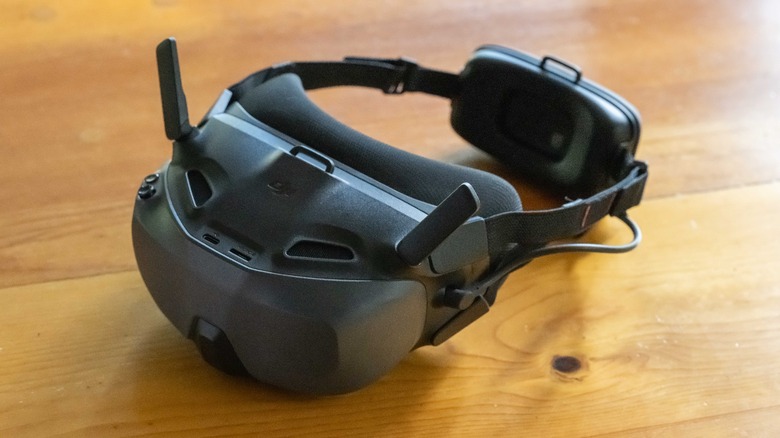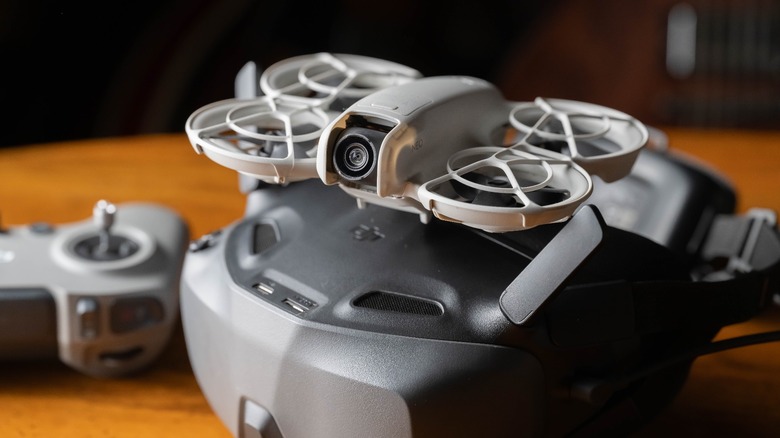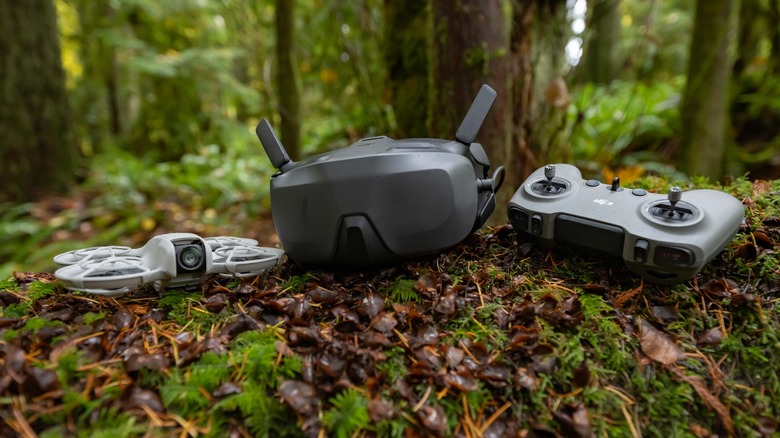We may receive a commission on purchases made from links.
RATING : 9 / 10
- Exceptionally wide FOV
- Accommodates prescription glasses
- Comfortable design
- Built-in battery
- Only compatible with two drones
- Oversized glasses may not fit
Few companies iterate upon their own products as frequently as DJI, and while this relentless pace of innovation delivers impressive upgrades time and time again, it can nonetheless grow a bit confusing for their customers. With the DJI Goggles N3, a lot of people will be wondering how they differ from all the other first person view (FPV) goggles which DJI sells, and if this might be the one from them.
Advertisement
On paper, the DJI Goggles N3 (provided here by DJI for this review) have a lot in common with the DJI Goggles 3, but there are some key differences which make the Goggles N3 a potentially compelling option – most notably their impressive upgrade to field of view (FOV). This should help with immersion, and if these goggles are as good as the spec sheet promises at the price DJI is asking, they could be compelling indeed. However, are these just for new customers, or should those who already own headsets consider upgrading?
Wide field of view boosts immersion
With a 54 degree field of view, the DJI Goggles N3 provide a significant boost compared to previous DJI headsets in this regard, as others such as the DJI Goggles 3 only provide a 44 degree FOV. This has a very real benefit to immersion, and makes the Goggles N3 a lot of fun to fly with.
Advertisement
The 1080p 60fps feed provides plenty of resolution at a smooth framerate, which is certainly a boon when flying in complex environments. I was able to navigate complex forests and interior spaces with ease and avoid hard-to-spot hazards. The LCD panels in the Goggles N3 aren’t as vibrant and realistic as the dual Micro-OLED screens in the DJI Goggles 3, but they still look great and are perfectly functional. It’s a worthy tradeoff to gain the additional field of view which the Goggles N3 offer.
The Goggles N3 utilizes DJI’s O4 digital video transmission system, along with a 2T4R antenna design, which is supposed to reduce interference and offer a range of up to 13km with an average latency of 31ms. I’m happy to report that I never experienced signal interference, and I was able to fly around trees in the forest and behind walls indoors without losing signal. Panoramic video playback is also available — just import the files onto a microSD card and insert it into the Goggles N3.
Advertisement
A comfy fit that’s easy to adjust
DJI headsets have come a long way since I first took to the sky with the original DJI FPV drone years ago, particularly in terms of comfort and adjustability. The DJI Goggles N3 are particularly comfortable, with cloth padding around the eyes that doesn’t get all nasty and sweaty like rubber padding. The rear pad on the integrated battery does have a rubbery texture, but on the back of your head that’s not really a problem.
Advertisement
It’s all secured by a strap which cranks down via a knob on the back of the integrated battery, allowing for a quick and easy fit that doesn’t require a lot of fiddly adjustments. It’s similarly easy to loosen, and if you need extra support on top of your head there are loops with which to affix an extra strap. On my head it was perfectly well supported with just the side straps.
A key feature of the DJI Goggles N3 is the fact that they support glasses wearers, though this is somewhat dependent on the size of your glasses. I have an extremely large head, and wear glasses to match, so my pair of oversized aviators did not fit at all inside the Goggles N3. However, my smaller spare pair did just manage to squeeze in.
Advertisement
On-headset controls are simple and straightforward, and will be familiar to anyone who’s used different DJI goggles in the past. Battery life is respectable at up to 2.7-hours on a charge, and I appreciate that DJI used their integrated battery design here. The headset balances well on my head and is comfortable for long periods of uninterrupted flight.
Only compatible with two drones
The biggest criticism I have of the DJI Goggles N3 is that they’re only compatible with the DJI Neo and the DJI Avata 2. That severely limits the potential audience for this headset, and if it was more widely compatible I’m sure it would appeal to quite a few drone pilots. Even the brand new DJI Air 3S isn’t compatible, which is puzzling, given that it’s newer even than the DJI Neo. By comparison, the DJI Goggles 3 can be paired with the DJI Air 3 and DJI Mini 4 Pro in addition to the DJI Neo and DJI Avata 2.
Advertisement
A few other key differences between the Goggles N3 and Goggles 3 are that the N3 can only do live feed sharing via USB-C, while the Goggles 3 is also capable of wireless wi-fi live feed sharing. Furthermore, the Goggles 3 support picture-in-picture real view so that you’re aware of your surroundings and have adjustable diopters, while the N3 rely on you wearing your own prescription eyewear.
Flying with the DJI Neo
As I did not have the DJI Avata 2 on hand, the full extent of my testing with the DJI Goggles N3 was done together with the DJI Neo. While the DJI Avata 2 is a superior drone in nearly every way, the DJI Neo is really an ideal pairing with the Goggles N3. The two match well, thanks to their relatively affordable price points, and once I had it in the air I quickly forgot I was flying with a budget-friendly drone.
Advertisement
I heaped praise upon the Neo in my recent review of that drone due how easy it is to use, even without a controller of any kind. Paired with the Goggles N3 it becomes a surprisingly awesome little FPV drone. There are real advantages to the small size of the Neo when flying in particularly tight spaces. The larger the drone, the higher the chance it has to clip obstacles and crash catastrophically.
Once I got used to flying the Neo in FPV, I found I could confidently slip through narrow cracks which I’d never have dared attempt with any other drone. Flying in a legacy forest with a dense and complex structure I was able to avoid most obstacles easily, and the one time I got a little too friendly with a branch the Neo managed to save itself from a collision which would have sent any other drone tumbling to the forest floor. This is probably thanks both to how lightweight the Neo is, and the fact that it has fully protected propellers, meaning the twigs weren’t able to get in and jam the blades.
Advertisement
Remarkably low price
With an MSRP of just $229, the Goggles N3 are among the least expensive FPV goggles which DJI currently sell, and represent a compelling bargain so long as you have a compatible drone. They deliver a lot of bang for your buck, and are the only DJI goggles which make sense financially to buy alongside the $199 DJI Neo.
Advertisement
Combined with that and the DJI FPV Remote Controller 3 at $199, you can put together a remarkably capable FPV drone kit for a total cost of just $627. You can shave a further $99 off that price if you get the DJI RC Motion 3 instead to pair with the headset and drone. The best thing about this setup would be that not only is it ready-to-go out-of-the-box, each component is readily replaceable at a relatively low cost. When flying acrobatically and in close proximity to the ground, crashes are a certainty rather than a mere possibility, so there’s good sense in picking up the Neo with the Goggles N3 if you’re just starting out.
Alternatively, the DJI Avata 2 is available for around $490 on Amazon, and is a big step up from the Neo. With the Goggles N3 and Controller 3, that makes for a total price of just a little over $900, so you save around $70 with the Goggles N3 compared to the standard Avata 2 bundle.
Advertisement
Conclusion
For the price, the DJI Goggles N3 are an extremely compelling headset for anyone wanting to add FPV capability to their DJI Neo. Combined with the DJI RC Motion 3, you can put together a really competent FPV setup for not much more than $500. That puts the most accessible FPV system ever made at a remarkably approachable price point. While there are still very good reasons to prefer the more expensive Goggles 3, the Goggles 3N are going to wow a lot of people, and their wider 55 degree field of view provides a real advantage.
Advertisement
As a glasses wearer, I did appreciate not having to fiddle with diopter settings, even though I had to wear my smaller pair of glasses. Really, the only fly in the ointment here is that the Goggles 3N aren’t compatible with more drones. The Goggles 3N are excellent overall and thanks to their affordable price are very easy to recommend.
The DJI Goggles 3N are available from DJI’s online store now for about $229.









